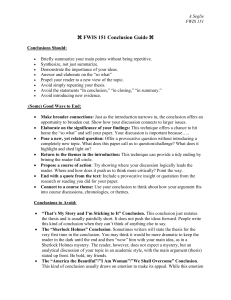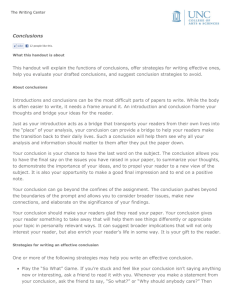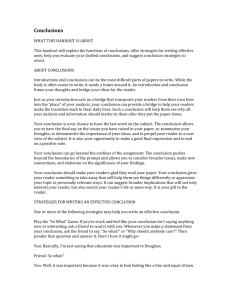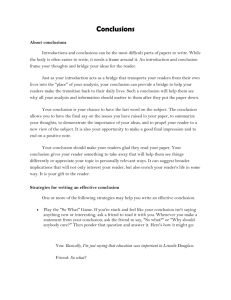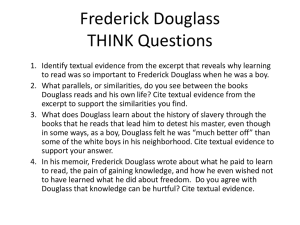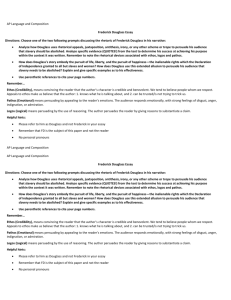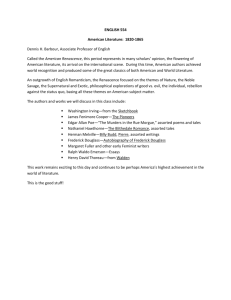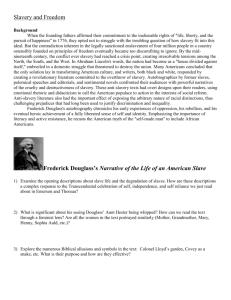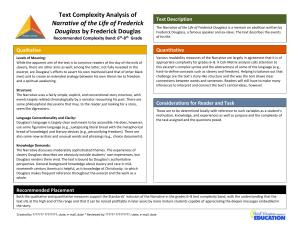conclusions File
advertisement
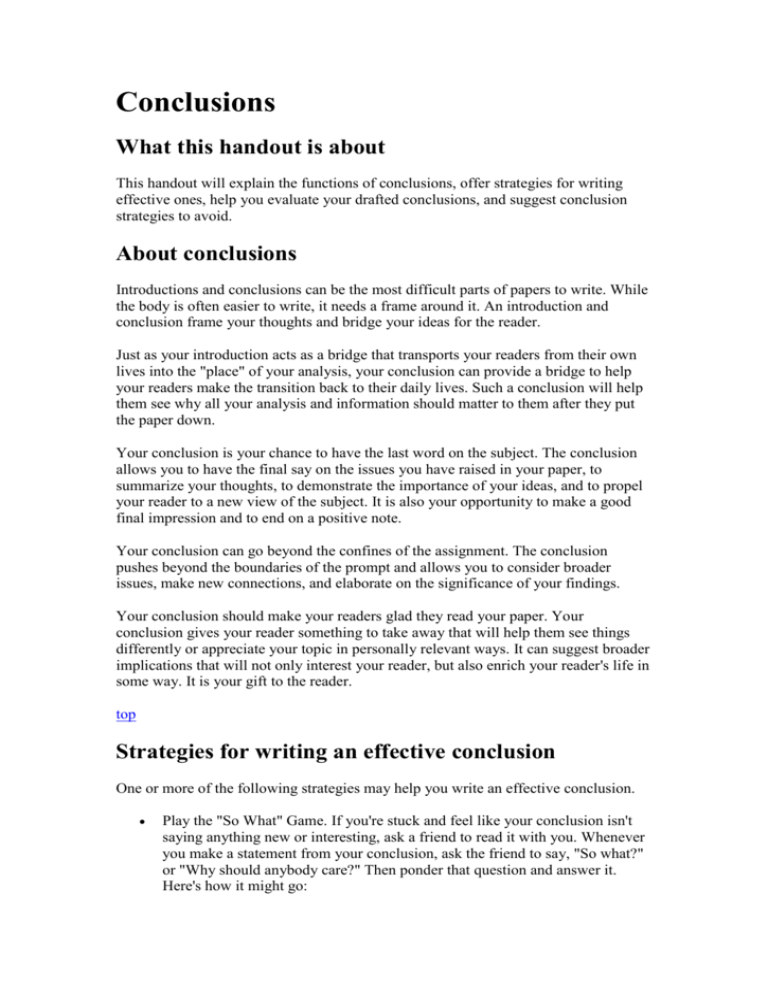
Conclusions What this handout is about This handout will explain the functions of conclusions, offer strategies for writing effective ones, help you evaluate your drafted conclusions, and suggest conclusion strategies to avoid. About conclusions Introductions and conclusions can be the most difficult parts of papers to write. While the body is often easier to write, it needs a frame around it. An introduction and conclusion frame your thoughts and bridge your ideas for the reader. Just as your introduction acts as a bridge that transports your readers from their own lives into the "place" of your analysis, your conclusion can provide a bridge to help your readers make the transition back to their daily lives. Such a conclusion will help them see why all your analysis and information should matter to them after they put the paper down. Your conclusion is your chance to have the last word on the subject. The conclusion allows you to have the final say on the issues you have raised in your paper, to summarize your thoughts, to demonstrate the importance of your ideas, and to propel your reader to a new view of the subject. It is also your opportunity to make a good final impression and to end on a positive note. Your conclusion can go beyond the confines of the assignment. The conclusion pushes beyond the boundaries of the prompt and allows you to consider broader issues, make new connections, and elaborate on the significance of your findings. Your conclusion should make your readers glad they read your paper. Your conclusion gives your reader something to take away that will help them see things differently or appreciate your topic in personally relevant ways. It can suggest broader implications that will not only interest your reader, but also enrich your reader's life in some way. It is your gift to the reader. top Strategies for writing an effective conclusion One or more of the following strategies may help you write an effective conclusion. Play the "So What" Game. If you're stuck and feel like your conclusion isn't saying anything new or interesting, ask a friend to read it with you. Whenever you make a statement from your conclusion, ask the friend to say, "So what?" or "Why should anybody care?" Then ponder that question and answer it. Here's how it might go: You: Basically, I'm just saying that education was important to Douglass. Friend: So what? You: Well, it was important because it was a key to him feeling like a free and equal citizen. Friend: Why should anybody care? You: That's important because plantation owners tried to keep slaves from being educated so that they could maintain control. When Douglass obtained an education, he undermined that control personally. You can also use this strategy on your own, asking yourself "So What?" as you develop your ideas or your draft. Return to the theme or themes in the introduction. This strategy brings the reader full circle. For example, if you begin by describing a scenario, you can end with the same scenario as proof that your essay is helpful in creating a new understanding. You may also refer to the introductory paragraph by using key words or parallel concepts and images that you also used in the introduction. Synthesize, don't summarize: Include a brief summary of the paper's main points, but don't simply repeat things that were in your paper. Instead, show your reader how the points you made and the support and examples you used fit together. Pull it all together. Include a provocative insight or quotation from the research or reading you did for your paper. Propose a course of action, a solution to an issue, or questions for further study. This can redirect your reader's thought process and help her to apply your info and ideas to her own life or to see the broader implications. Point to broader implications. For example, if your paper examines the Greensboro sit-ins or another event in the Civil Rights Movement, you could point out its impact on the Civil Rights Movement as a whole. A paper about the style of writer Virginia Woolf could point to her influence on other writers or on later feminists. top Strategies to avoid Beginning with an unnecessary, overused phrase such as "in conclusion," "in summary," or "in closing." Although these phrases can work in speeches, they come across as wooden and trite in writing. Stating the thesis for the very first time in the conclusion. Introducing a new idea or subtopic in your conclusion. Ending with a rephrased thesis statement without any substantive changes. Making sentimental, emotional appeals that are out of character with the rest of an analytical paper. Including evidence (quotations, statistics, etc.) that should be in the body of the paper. top Four kinds of ineffective conclusions 1. The "That's My Story and I'm Sticking to It" Conclusion. This conclusion just restates the thesis and is usually painfully short. It does not push the ideas forward. People write this kind of conclusion when they can't think of anything else to say. Example: In conclusion, Frederick Douglass was, as we have seen, a pioneer in American education, proving that education was a major force for social change with regard to slavery. 2. The "Sherlock Holmes" Conclusion. Sometimes writers will state the thesis for the very first time in the conclusion. You might be tempted to use this strategy if you don't want to give everything away too early in your paper. You may think it would be more dramatic to keep the reader in the dark until the end and then "wow" him with your main idea, as in a Sherlock Holmes mystery. The reader, however, does not expect a mystery, but an analytical discussion of your topic in an academic style, with the main argument (thesis) stated up front. Example: (After a paper that lists numerous incidents from the book but never says what these incidents reveal about Douglass and his views on education): So, as the evidence above demonstrates, Douglass saw education as a way to undermine the slaveholders' power and also an important step toward freedom. 3. The "America the Beautiful"/"I Am Woman"/"We Shall Overcome" Conclusion. This kind of conclusion usually draws on emotion to make its appeal, but while this emotion and even sentimentality may be very heartfelt, it is usually out of character with the rest of an analytical paper. A more sophisticated commentary, rather than emotional praise, would be a more fitting tribute to the topic. Example: Because of the efforts of fine Americans like Frederick Douglass, countless others have seen the shining beacon of light that is education. His example was a torch that lit the way for others. Frederick Douglass was truly an American hero. 4. The "Grab Bag" Conclusion. This kind of conclusion includes extra information that the writer found or thought of but couldn't integrate into the main paper. You may find it hard to leave out details that you discovered after hours of research and thought, but adding random facts and bits of evidence at the end of an otherwise-well-organized essay can just create confusion. Example: In addition to being an educational pioneer, Frederick Douglass provides an interesting case study for masculinity in the American South. He also offers historians an interesting glimpse into slave resistance when he confronts Covey, the overseer. His relationships with female relatives reveal the importance of family in the slave community. top Works consulted We consulted these works while writing the original version of this handout. This is not a comprehensive list of resources on the handout's topic, and we encourage you to do your own research to find the latest publications on this topic. Please do not use this list as a model for the format of your own reference list, as it may not match the citation style you are using. For guidance on formatting citations, please see the UNC Libraries citation tutorial. All quotations are from: Douglass, Frederick. Narrative of the Life of Frederick Douglass, an American Slave, edited and with introduction by Houston A. Baker, Jr., New York: Penguin Books, 1986. Strategies for Writing a Conclusion. Literacy Education Online, St. Cloud State University. 18 May 2005 <http://leo.stcloudstate.edu/acadwrite/conclude.html>. Conclusions. Nesbitt-Johnston Writing Center, Hamilton College. 17 May 2005 <http://www.hamilton.edu/academic/Resource/WC/SampleConclusions.html>. top Handout Contents What this handout is about... About Conclusions Why bother writing a good conclusion? Effective strategies Ineffective strategies Common ineffective Conclusions Sources Other UNC Handouts Writing the Paper Argument Audience Brainstorming College Writing Conclusions Evaluating Print Sources Evidence Fallacies Getting Feedback Introductions Paragraph Development Procrastination Reading to Write Reorganizing Drafts Reading Aloud Revising Drafts Spell-check Programs Statistics Summary Thesis Statements Track Changes Transitions Understanding Assignments Using the Library Writing Anxiety Writing Groups Citation, Style, and Sentence-Level Concerns Articles Citation Resources Commas Conditionals Editing and Proofreading Fragments and Run-ons Gender-Sensitive Language Passive Voice Plagiarism Quotations Should I Use"I"? Style Word Choice Specific Writing Assignments Abstracts Annotated Bibliographies Application Essays Book Reviews Business Letters Comparing/Contrasting Dissertations Essay Exams Grant Proposals Honors Theses Literature Reviews Oral History Poetry Explications Scientific Research Reports Speeches Writing for Specific Fields Anthropology Art History Communication Studies History Literature (Fiction) Philosophy Political Science Religious Studies Sciences Sociology This work is licensed under a Creative Commons AttributionNonCommercial-NoDerivs 2.5 License. You may reproduce it for non-commercial use if you use the entire handout (just click print) and attribute the source: The Writing Center, University of North Carolina at Chapel Hill This work is licensed under a Creative Commons AttributionNonCommercial-NoDerivs 2.5 License. www.unc.edu/depts/wcweb 1998 - 2007
